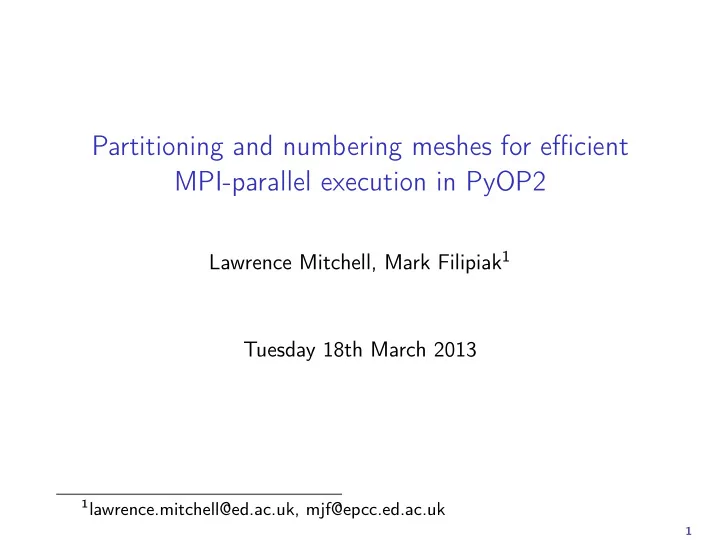

Partitioning and numbering meshes for efficient MPI-parallel execution in PyOP2 Lawrence Mitchell, Mark Filipiak 1 Tuesday 18th March 2013 1 lawrence.mitchell@ed.ac.uk, mjf@epcc.ed.ac.uk 1
Outline Numbering to be cache friendly Numbering for parallel execution Hybrid shared memory + MPI parallelisation 2
Modern hardware ◮ Latency to RAM is 100s of clock cycles ◮ Multiple caches to hide this latency ◮ memory from RAM arrives in cache lines (64 bytes, 128 bytes on Xeon Phi) ◮ hardware prefetching attempts to predict next memory access 3
Exploiting hardware caches in FE assembly ◮ Direct loops over mesh entities are cache-friendly ◮ indirect loops may not be ◮ can we arrange them to be cache friendly? 4
A mesh 5
Cache friendly visit order (default numbering) 6
Cache friendly visit order (default numbering) 6
Cache friendly visit order (default numbering) 6
Mesh entity numbering is critical ◮ arrange for “connected” vertices to have a good numbering (close to each other) ◮ given this good numbering ◮ derive numberings for other entities 7
Numbering dofs ◮ Cover mesh with space-filling curve ◮ vertices that are close to each other get close numbers 8
Other entities ◮ construct additional entities with some numbering ◮ sort them and renumber lexicographically keyed on sorted list of vertices they touch ◮ do this every time the mesh topology changes ◮ (doesn’t work yet) 9
Comparing 10
Does it work? ◮ In Fluidity ◮ P1 problems get around 15% speedup ◮ In PyOP2 ◮ GPU/OpenMP backends get 2x-3x speedup (over badly numbered case) ◮ Fluidity kernels provoke cache misses in other ways 11
Iteration in parallel ◮ Mesh distributed between MPI processes ◮ communicate halo data ◮ would like to overlap computation and communication 12
Picture 13
Comp/comms overlap ◮ entities that need halos can’t be assembled until data has arrived ◮ can assemble the other entities already start_halo_exchanges() for e in entities: if can_assemble(e): assemble(e) finish_halo_exchanges() for e in entities: if still_needs_assembly(e): assemble(e) 14
Making this cheap ◮ separate mesh entities into groups start_halo_exchanges() for e in core_entities: assemble(e) finish_halo_exchanges() for e in additional_entities: assemble(e) 15
PyOP2 groups ◮ Core entities ◮ can assemble these without halo data ◮ Owned entities ◮ local, but need halo data ◮ Exec halo ◮ off-process, but redundantly executed over (touch local dofs) ◮ Non-exec halo ◮ off-process, needed to compute exec halo 16
Why like this? ◮ GPU execution ◮ launch separate kernels for core and additional entities ◮ no branching in kernel to check if entity may be assembled ◮ Defer halo exchange as much as possible (lazy evaluation) 17
How to separate the entities ◮ separate data structures for different parts ◮ possible, but hurts direct iterations, and is complicated ◮ additional ordering constraint ◮ core, owned, exec, non-exec ◮ implemented in Fluidity/PyOP2 ◮ each type of mesh entity stored contiguously, obeying this ordering 18
Hybrid shared memory + MPI parallelisation ◮ On boundary, assembling off-process entities can contribute to on-process dofs ◮ how to deal with this? ◮ use linear algebra library that can deal with it ◮ e.g. PETSc allows insertion and subsequent communication of off-process matrix and vector entries ◮ Not thread safe 19
Solution ◮ Do redundant computation ◮ this is the default PyOP2 computation model ◮ Maintain larger halo ◮ assemble all entities that touch local dofs ◮ turn off PETSc off-process insertion 20
Picture 21
Multiple gains ◮ You probably did the halo swap anyway ◮ this makes form assembly non-communicating ◮ we’ve seen significant (40%) benefit on 1000s of processes (Fluidity only) ◮ thread safety! 22
Thread safety ◮ Concurrent insertion into MPI PETSc matrices is thread safe if: ◮ there’s no off-process insertion caching ◮ user deals with concurrent writes to rows ◮ colour the local sparsity pattern 23
Corollary ◮ It is possible to do hybrid MPI/OpenMP assembly with existing linear algebra libraries ◮ implemented (and tested!) in PyOP2 ◮ Ongoing work to add more shared memory parallisation in kernels in PETSc ◮ PETSc team ◮ Michael Lange (Imperial) 24
Conclusions ◮ With a bit a of work, we can make unstructured mesh codes reasonably cache friendly ◮ For good strong scaling, we’d like to overlap computation and communication as much as possible, but cheaply ◮ We think the approaches here work, and are implemented in Fluidity/PyOP2 25
Acknowledgements ◮ Hilbert reordering in Fluidity: ◮ Mark Filipiak (EPCC) [a dCSE award from EPSRC/NAG] ◮ Lexicographic mesh entity numbering and ordering in Fluidity: ◮ David Ham (Imperial), and me (prodding him along the way) ◮ PyOP2 MPI support: ◮ me (EPCC) [EU FP7/277481 (APOS-EU)] ◮ ideas from Mike Giles and Gihan Mudalige (Oxford) ◮ MAPDES team: ◮ funding (EPSRC grant EP/I00677X/1, EP/I006079/1) 26
Recommend
More recommend